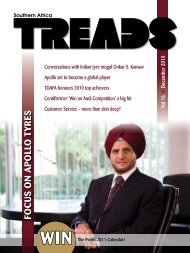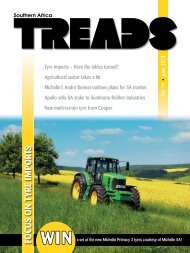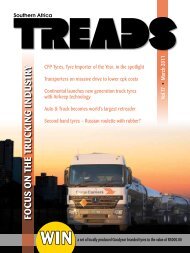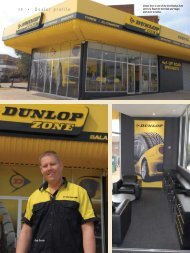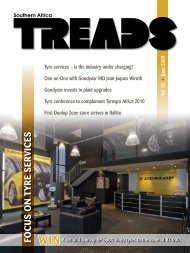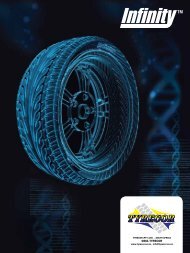Download - SA TREADS
Download - SA TREADS
Download - SA TREADS
You also want an ePaper? Increase the reach of your titles
YUMPU automatically turns print PDFs into web optimized ePapers that Google loves.
Have a<br />
question?<br />
Send it to satreads@mweb.co.za<br />
Q<br />
Do I need special tyre changing machines to service run-flat tyres?<br />
A<br />
While most extended mobility tyres appear to be the same as a regular<br />
tyre, the sidewall areas are usually reinforced and much stiffer. Without<br />
the proper equipment to depress the sidewall during the demount and mount<br />
processes, the likelihood of torn beads and damaged rims increases. In order<br />
to properly service most run-flat tyres, the machine must have the hydraulic<br />
arms and/or rollers to keep the bead in the drop center.<br />
Q<br />
Is there still a global shortage of OTR tyres?<br />
A<br />
The only shortage that still remains to some degree is the large<br />
earthmover tyres with 57- and 63-inch rim diameters. Small- and<br />
medium-sized OTR tyres are in good supply, and with the global demand<br />
for new earthmoving equipment continuing to shrink, we expect inventories<br />
to remain at high levels for most OTR tyres.<br />
44 • Ask the tyre experts<br />
Ask the tyre experts<br />
With Marvin Bozarth and Kevin Rohlwing, Tire Industry Association<br />
Q<br />
How many splices are acceptable on a<br />
pre-cure retread?<br />
A<br />
Most retreaders will only allow one splice<br />
per retread, but some companies will allow<br />
two splices with shallow tread depth rubber where<br />
the vehicles do not operate at highway speed or<br />
are fully loaded.<br />
Marvin Bozarth<br />
Q<br />
Can inflation gauges be calibrated?<br />
A<br />
Yes, truck tyre gauges have a small screw on<br />
the bottom of the “stick” that pops out when<br />
Kevin Rohlwing<br />
the air pressure is checked. When the gauge is checked against a master<br />
gauge or at a calibration station, the screw can be tightened or loosened to<br />
read the exact pressure.<br />
Q<br />
How can I improve envelope life in my retread plant?<br />
A<br />
The most important thing you can do is check the sealing rings,<br />
hooks and platforms for any sharp edges or burrs. A small nick or<br />
burr can poke a hole in an envelope or start a small cut that eventually<br />
works it way all the way through rubber. It’s also important to store the<br />
envelopes flat but off the ground on a platform without sharp edges or<br />
protruding nails, which is why we don’t recommend using a wooden pallet.<br />
Another important thing is to let the envelopes cool evenly and make sure<br />
that housekeeping in the plant minimizes the number of staples and other<br />
objects on the floor that may puncture an envelope. Finally, choosing<br />
the correct size and ensuring no foreign material is trapped between the<br />
envelope and the tyre will improve envelope life.<br />
Q<br />
I read that tyres run cooler when inflated with nitrogen. Is that true?<br />
A<br />
None of the tyre manufacturers can produce any data showing that<br />
nitrogen makes a tyre run cooler or last longer. The main factor that<br />
contributes to heat inside a tyre – besides the proper inflation pressure for<br />
the load – is moisture. Moist air retains more heat than dry air, so installing<br />
water separators or air dryers will almost eliminate the moisture and allow<br />
the tyre to run cooler. While nitrogen does bleed out at a slower rate than<br />
regular air (which is already 80% nitrogen), regular inflation pressure<br />
maintenance combined with dry air will yield the same benefits attributed<br />
to nitrogen.<br />
Q<br />
What is the best bead lubricant for truck tyres?<br />
A<br />
We always look for vegetable- or animal-based products that contain<br />
a rust inhibitor with no petrochemical products. Paste lubricants are<br />
typically best for mounting tyres, because they don’t dry as quickly and<br />
typically result in a tyre that is concentrically seated on the rims. One of the<br />
biggest problems we see is technicians who lube the beads with a waterbased<br />
lubricant on a bunch of tyres and then proceed to mount them all<br />
at once. The first few still get the advantages of bead lube, but the last few<br />
are basically dry. Paste lubes don’t evaporate as quickly and also create less<br />
mess in the service area.<br />
To submit a question to be answered in a future edition of Southern<br />
Africa Treads, please send your questions to satreads@mweb.co.za.<br />
Marvin Bozarth is the senior technical consultant for the Tire Industry<br />
Association (TIA) and has more than 40 years of tire and retreading<br />
experience. Kevin Rohlwing is the senior vice president of training for TIA<br />
and has over 26 years of tire experience. TIA offers some of the most<br />
comprehensive tyre service training programs for both commercial<br />
and automotive tyre service professionals in the world. For more<br />
information on these programs, or for more information on TIA, visit<br />
www.tireindustry.org or email training@tireindustry.org.



